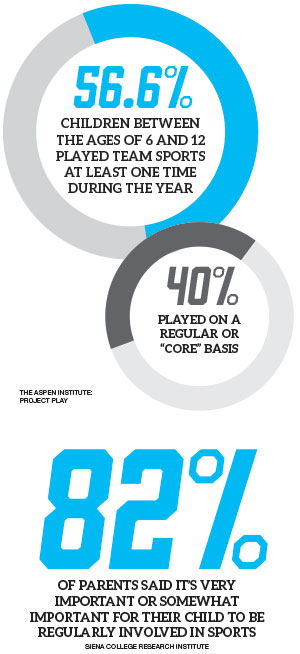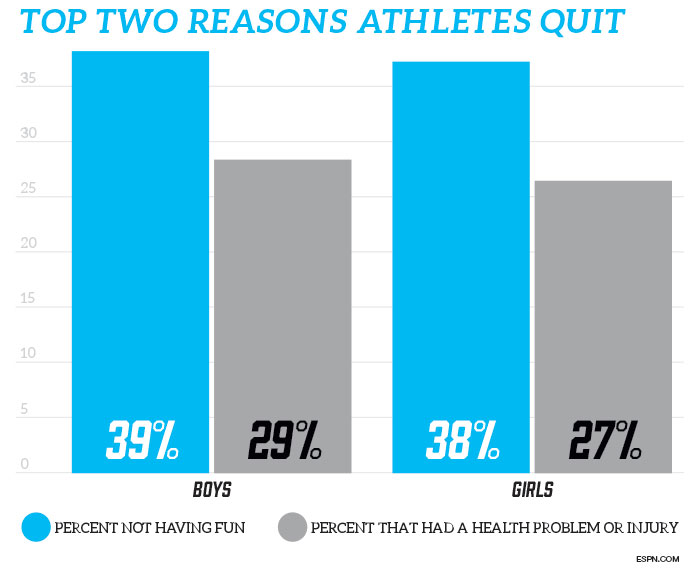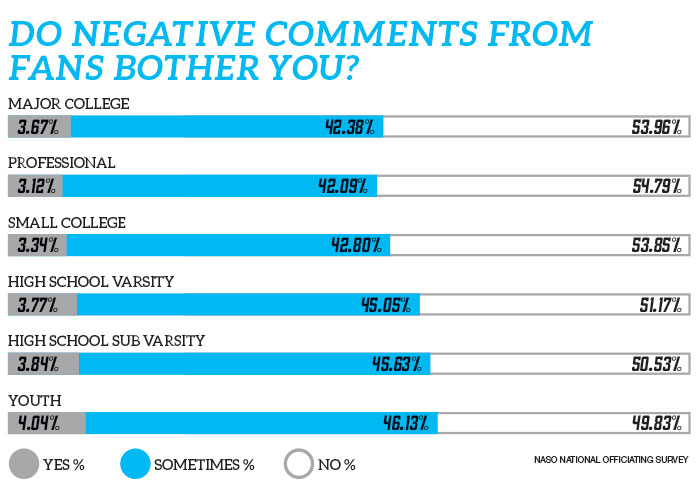Sports and American culture — the two are practically inseparable. Young children through those in their golden years get a thrill from the engaging competitive spirit and physical activity sports provide. Whether regularly participating in sports, avidly cheering on a favorite team, or dabbling in sports interests as opportunities allow, most Americans have some interaction with sports.
Unfortunately, the expression of enthusiasm for sports displayed by many people is too often negative. The competitive spirit that gets adrenaline pumping and brings excitement with hopes to see the desired team reign victorious is taken too far. It is not an uncommon occurrence to observe fans screaming obscenities on the sidelines, athletes and coaches expressing poor attitudes, or to see coverage in the media about a fight between parents at the most recent youth competition.
In the midst of wanting to win so badly, some get wrapped up in believing there must be someone to blame if their team is not winning. It could be the fault of the athletes, the coaches, or all too often, the officials. The “culprits” become targets for verbal, and sometimes even physical, abuse. In other circumstances, the desire to minimize the risk of losing is so great that rules are taken advantage of and attempts are made to find any loophole rather than play within the spirit of the competition.
How did the sports arena travel so far down the path of allowing these behaviors? How did sports go from being a fun way to promote social involvement, healthy competition and physical activity to the battles that are used to prove superiority? There is no doubt that a win-at-all-cost attitude has become prevalent in many sporting circles. And while competition can certainly be a healthy and desirable part of the American life, much work should be done in redefining how enthusiasm for sport is expressed acceptably and in protecting all of those who are currently suffering from being targets of abuse.
The problem of poor sporting behavior has incredible depth requiring incredible efforts to resolve. However, with a focus on youth and high school sports, involving the largest number of officials, we will come a long way with a greater understanding of the benefits of and threats to sports, why officials matter, who is the most responsible for sportsmanship problems and how to seek solutions.
What are the benefits of sports?
Involvement in sports leads to enhanced life experiences outside of sports.
 Athletes
Athletes
Over half of American children play team sports and have the fortune of improved opportunities for development as a result. In a report, the U.S. Government Accountability Office (GAO) cites research that indicates there are health, academic, personal and social benefits for school-aged youth involved in sports. While the health benefits of sports resulting in healthier bones and joints along with reduced obesity may seem obvious, the academic benefits will also impact athletes throughout their lives. Based on conclusions drawn from a Centers for Disease Control report, the GAO stated, “Specifically, it concluded there is substantial evidence that physical activity can help improve academic achievement, including grades and standardized test scores,” and added that, “… sports in particular, can positively affect aspects of personal development among young people such as self-esteem, goal-setting and leadership.” Furthermore, in “The Confidence Code: The Science and Art of Self-Assurance — What Women Should Know,” Kathy Kay and Claire Shipman write, “There’s even a direct link between playing sports in high school and earning a higher salary later in life. Learning to own victory and defeat in sports is a useful tool for owning triumphs and setbacks at work”.
Parents
Parents appreciate the benefits of youth sports as most of them desire to provide the best opportunities for growth and success to their children as possible. Involvement in sports gives many parents the peace of mind that they are opening the door to development that will lead to numerous successes throughout their children’s lives. In fact, according to a survey by the Siena College Research Institute commissioned by the Aspen Institute, “In Southeast Michigan, 82 percent of parents said it’s very important or somewhat important for their child to be regularly involved in sports.”
Officials
In addition to athletes and parents, officials also reap great rewards. Just like with athletes, the physical health benefits are fairly obvious. But officiating also provides opportunities to become leaders and role models. Some skills that are developed involve interpersonal communication, decision-making, conflict resolution and dealing with stress. The social-networking opportunities and friendships gained in the officiating world are incredible. And of course, the financial benefits should not be overlooked.

How Does sportsmanship threaten youth sports?
The effects of Poor sportsmanship go far beyond a minor annoyance — athletes and officials walk away.
Although participation in sports has been proven to have a multitude of benefits, the opportunity to reap those benefits is being jeopardized by poor sportsmanship. For example, one of the benefits of participation in sports is increased self-esteem. However, it can be deduced that if athletes are the targets of poor sportsmanship, they are not as likely to experience the same benefits and development in their level of self-esteem. Participants’ experiences in sport can go from positive to negative as a result of their own or others’ poor behavior. In fact, the frequency seems to be growing in those experiences becoming so negative that participants are not just losing out on reaching the full potential of the benefits, many sacrifice the opportunity to gain any benefit as they choose to completely walk away. Too often in professional sports all the way down through recreational levels, aggressive, demeaning and other types of unsporting behavior by both active participants and spectators are viewed simply as a part of the competition and a traditionally acceptable part of sports. But while competition can certainly be healthy and enjoyable, acting unfairly or with a lack of respect is not a necessary or acceptable part of any sports competition.
 Athletes
Athletes
 When athletes are the targets of poor sportsmanship, they suffer emotionally and being involved is no longer fun. Some athletes work through the criticism, but others decide it just is not worth it. More athletes quit sports because they were no longer having fun than for any other reason. Certainly, displays of poor sportsmanship, particularly those that are targeted at athletes, contribute to this diminished sense of fun.
When athletes are the targets of poor sportsmanship, they suffer emotionally and being involved is no longer fun. Some athletes work through the criticism, but others decide it just is not worth it. More athletes quit sports because they were no longer having fun than for any other reason. Certainly, displays of poor sportsmanship, particularly those that are targeted at athletes, contribute to this diminished sense of fun.
A total of 17,487 officials responded to the NASO National Officiating Survey. As a result of their efforts, insights can be gained and conclusions can be drawn, which will continue to move the industry into the future. See the survey results at naso.org/survey.
Officials
Athletes are not the only participants that walk away from their involvement as a result of poor sportsmanship. Recruiting and retaining officials has become a major concern across all sports. If the primary reason for becoming a sports official is for the love of the game, the level of appreciation for the sport will unsurprisingly dwindle when not enough is done to prevent verbal abuse, and sometimes even physical abuse. When a disproportionately high number of trips onto the court or field result in unpleasant interactions, many officials decide that their energy and enthusiasm would be better invested elsewhere.


Why Do officials matter?
“Who needs officials anyway? let the games go on without them!”
While there may be some people that do not value the contributions officials make to sports, they are an integral part of sports competitions. In fact, if there is a desire to continue providing both opportunities for competitions and access to all of the benefits sports have to offer, the shortage of officials is a problem that must be combatted. Without officials, competitions cannot be held. Conversations about the shortage of officials may seem commonplace and a problem that will have to be addressed down the road. But, there is not time to wait to address the problems causing the shortage of officials, sportsmanship being a primary one, because the impact is escalating. An alarming number of sports administrators have expressed that competitions have had to be rescheduled or canceled at least occasionally.
Canceled?
Some would ask whether the step of rescheduling and canceling competitions is really necessary. After all, most of the athletes are pretty familiar with the rules and the competitions could just go on without officials, right?
Wrong. Two of the primary responsibilities of officials across all sports is to promote fair play and protect player safety. When officials are not present, the games may go on, but not without the risk of injury going up. In The Council on Sports Medicine and Fitness, Chris G. Koutures and Andrew J.M. Gregory said, “There is consensus that proper rule enforcement and limitation of violent contact can reduce the risk of injury.” And in “Injury Prevention,” “One study said of competitors in nine different sports in 100 U.S. high schools identified 98,066 injuries over a two-year period that occurred as a direct result of an illegal activity as ruled by a referee or disciplinary committee.”
While this information has caught the attention of the medical community, it also causes warning alarms to go off among parents. Nearly nine out of 10 respondents to an espnW/Aspen Institute Project Play Survey said risk of injury is one of their greatest concerns when enrolling their children in sports. In order to keep participant numbers up, it is important that organizations mitigate parents’ concerns by minimizing the risk of injury.
Officials, it turns out, are not just an extraneous addition to sports competitions; they play a huge role in the aversion of injury risks for participants. And this is without even considering their undertaking of preventing poor sportsmanship to the extent possible at competitions.

Who causes sportsmanship issues?
Administrators, Coaches, and officials agree — parents are the greatest obstacle to positive environments.
Ultimately, everyone needs to take responsibility for finding the solutions to sportsmanship issues. Certainly, each individual needs to be aware of the impact that his or her action or inaction regarding poor sportsmanship has on everyone involved. But poor sportsmanship seems to be a bigger problem at some levels than at others, and certain groups of people instigate more of the issues.
Parents
It may seem counterintuitive that the athletes, or active participants, are not considered the party most responsible for sportsmanship concerns. But officials are not the only ones that believe that parent and spectator behavior is notably problematic. NFHS found in a survey that of its state association executive directors, 76 percent felt spectators cause significant problems with sportsmanship, while a lower percentage (68 percent) felt the participants cause significant problems with sportsmanship. And that begs the question about how many of the problems initiated by active participants are actually displaying a mirror of behaviors athletes have learned from their parents’ attitudes and actions at sporting events.
What would you do?
How would you respond if your child were involved in a sport in which the coach screamed and swore regularly at him or her? What if your child did not want you to say or do anything? Would you? What if you were the assistant coach while this happened at a practice? What would you do? What if you were just out for a walk in your neighborhood park and saw this happening? Would you step in? Would your response to any of these questions change based on the sport? Is it more acceptable to scream at athletes in a sport like football than in one like dance?

What solutions are being tried?
Initiatives promote sporting behavior, Positive culture.
Some of initiatives that have been tried include:
Silent September
During September 2017, South Carolina Youth Soccer tried “Silent” September. Parents and visitors could not cheer or jeer — silent really meant silent, with no yelling, clapping or making noise at any time the ball was in play. Violators would be removed. The exercise was to start a conversation and raise awareness of unsporting behavior — particularly the sideline behavior of parents. League officials say it was positively received, even by the parents.
Zero Tolerance Policy
The North Carolina Athletic Association (NCHSAA) created protocols that only allowed the head coach to question a call on the field, court or mat; and allowed zero inappropriate language or profanity by players or coaches, whether directed at an opponent, official or himself or herself. And officials who didn’t properly penalize players and coaches for inappropriate behavior faced suspension — a step designed to ensure officials were taking care of business.
Positive Coaching Alliance
Through online courses and workshops, the Positive Coaching Alliance (PCA) aims to help those involved in youth and high school sports create a positive, character-building youth sports culture — including players, coaches, parents and fans. The PCA aims to help leagues and schools create a culture that promotes sporting behavior.
What's Your Call? Leave a Comment:
Note: This article is archival in nature. Rules, interpretations, mechanics, philosophies and other information may or may not be correct for the current year.
This article is the copyright of ©Referee Enterprises, Inc., and may not be republished in whole or in part online, in print or in any capacity without expressed written permission from Referee. The article is made available for educational use by individuals.



















